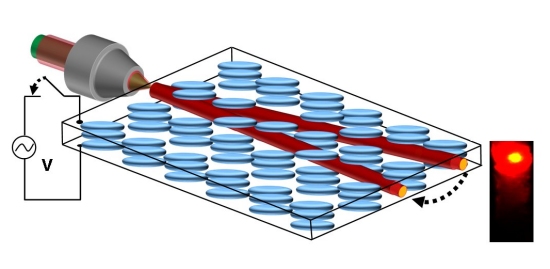TECH

Random Laser Transistor Electronic Gasket with Photonics
Electrically controlled laser
The lasers are ready to make another leap in quality: it has just been demonstrated that it is possible to control the direction of the output beam of a laser by applying an electric charge to it.Put simply, imagine the possibility of having a laser pen that can be programmed to play with your cat without having to turn the pen around - the light goes out of the laser in the direction you program.Of course, the goal is not exactly to play with your pussies: laser surgery, cutting of metal in the industry and routing of telecommunications can be done much more accurately and dispense with all the electromechanical apparatus currently used to move the laser."There is a lot of work yet to be done, but this is a first clear proof of a random laser transistor, in which laser emission can be routed and directed by the application of an external voltage," said Professor Giuseppe Strangi of Case University Western, in the USA.Random lasers have been the flagship of research in this area for more than 15 years because of their potential for miniaturization - they are nanolasers, suitable for being embedded inside photonic chips for communication and on processors that work with light instead of electricity .

Random laser transistor
Conventional lasers consist of an optical cavity, formed by two mirrored walls, within which there is a photoluminescent material that emits and amplifies light. The mirrors force the photons to jump from one side to another on a specific frequency, to produce the coherent beam of light that we see coming out."But what if we wanted to miniaturize that and get rid of the mirrors and make a laser with no cavity and go down to the nanoscale? This is a real world problem that we can not overcome until the turn of the century, even random lasers," explained Strangi .In random lasers, the photons emitted in various directions are gathered by means of a liquid crystal, which guides the light particles. Therefore, there is no need for the large mirror structure of traditional lasers.These lasers generate a special wave, called soliton, which acts as a channel for dispersed photons to follow, now on an orderly and concentrated path.What has now been done is to direct an electrical signal to the liquid crystal to control it precisely, which allows you to guide the laser as if it had a control button instead of moving the whole structure.
"That's why we call it 'transistor', because a weak signal, the soliton, controls a strong, laser output," explained Strangi. "Lasers and transistors have been the two leading technologies that revolutionized the last century, and we now find that both are interconnected in the same physical system."
Bibliography:
Beaming random lasers with soliton control
Sreekanth Perumbilavil, Armando Piccardi, Raouf Barboza, Oleksandr Buchnev, Martti Kauranen, Giuseppe Strangi, Gaetano Assanto
Nature Communications

No comments:
Post a Comment